Credit Sesame discusses the recent meeting of the Federal Open Market Committee and the decision not to cut interest rates.
The Federal Reserve concluded the May 2024 meeting of its Federal Open Market Committee (FOMC) by announcing that it was not ready to start cutting interest rates. The further delay in the Fed’s plans to reduce interest rates was largely taken in stride. While investors began the year eagerly awaiting rate cuts, they have recognized that inflation is driving the current rate policy.
Hoped for cut to interest rates not happening
The Fed announced that it would maintain its current rate policy range of 5.25% to 5.5%. The Fed started the year forecasting that it would make the equivalent of three 0.25% rate cuts in 2024. Now it seems rate cuts may be later and possibly milder than expected.
The Fed has used higher rates to try to suppress inflation. Following its recent meeting, the Fed noted that it does not expect to begin cutting rates “until it has gained greater confidence that inflation is moving sustainably toward 2 percent.”
According to the most recent reading of the Personal Consumption Expenditures (PCE) price index, the inflation rate over the past 12 months was 2.7%. The PCE price index is the Fed’s preferred measure of inflation.
2.7% isn’t far above the Fed’s 2% target. However, inflation increased at a much higher rate in the first quarter of 2024 than it did in the last quarter of 2023. So, inflation has been moving in the wrong direction of late, causing the Fed to be cautious about cutting rates.
Fed slows the pace of quantitative tightening
Interestingly, while people have been looking for the Fed to cut interest rates, it has actually been making a subtle move to drive some rates higher.
“Quantitative easing” occurs when the Fed buys fixed-income securities in an effort to drive yields down. While the Fed funds rate affects short-term interest rates, longer-term rates—which include the rates of many loans—are driven by market forces. Quantitative easing is a way the Fed can influence those market forces by buying bonds.
“Quantitative tightening” is the opposite. If the Fed is a net seller of bonds, it can push long-term rates higher. Having bought a tremendous amount of bonds in its effort to cut rates a few years ago, at some point, the Fed needs to sell those bonds. It started doing this by not rolling over some of the bonds it owns when they reach their maturity date.
This approach is intended to have a mild impact on the market, as opposed to the more drastic impact that would result from the Fed actively selling bonds. However, after last week’s meeting, the Fed announced it would slow the tightening process, which would make the impact even milder.
The Fed might be reacting to recent rising mortgage rates. The Fed’s battle against inflation is better served by reining in short-term spending, such as credit card purchases, than by suppressing long-term investments like home buying.
Rising compensation fuels consumers and inflation
Consumer spending has been getting an additional boost lately from compensation growth. Total compensation costs—which include both wages and benefits—rose by 4.2% over the past 12 months, even faster than the pace of inflation. The growth pace of compensation costs accelerated further in the first quarter of 2024. Compensation costs grew by 1.2% in the first quarter, which would project to an annual pace of nearly 4.9%.
The good news is that a high rate of compensation growth helps consumers stay ahead of inflation. The bad news is the costs involved in providing that compensation could prolong high inflation.
Employment
A strong job market is driving the rapid pace of compensation growth. Employment has grown for 40 straight months, and the unemployment rate is low, which means the demand for labor is high.
Slowing job growth could break this cycle. The employment report for April showed a net job creation of 175,000. While still positive, that’s a slowdown from March’s increase of 315,000 and from the monthly average of 242,000 over the past year.
A single month does not make a trend, but April’s job creation was a small step in the right direction. However, it will take a lot more than that to cool down inflation.
Impact on consumers
The reality is that interest rates will be higher for longer than originally expected. For consumers, that means no immediate relief from high borrowing costs. The best way for consumers to adapt to this situation may be to:
- Pay down debt. If interest rates are going to remain high, the best way to bring down borrowing costs is to reduce the amount you owe. This is especially true of high-interest credit card debt.
- Build up savings. Borrowers are hurt by high interest rates, and savers benefit. Saving more now means getting more out of today’s higher savings account rates and bond yields.
- Improve credit. People with higher credit scores usually qualify for better interest rates on loans and credit cards. Even if interest rates, in general, aren’t coming down yet, you could get a better rate by improving your credit score.
High inflation has not gone away as quickly as the Fed had hoped. Until it does, these steps would help consumers adapt to a continued environment of higher prices and interest rates.
If you enjoyed The Fed is not ready to cut interest rates you may like,
Disclaimer: The article and information provided here is for informational purposes only and is not intended as a substitute for professional advice.




















